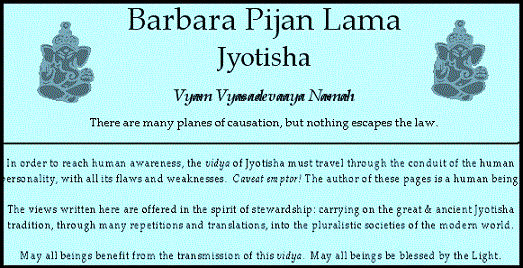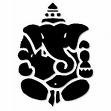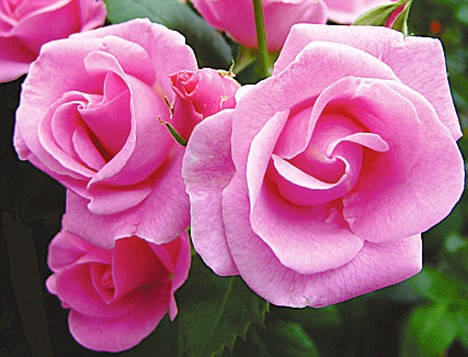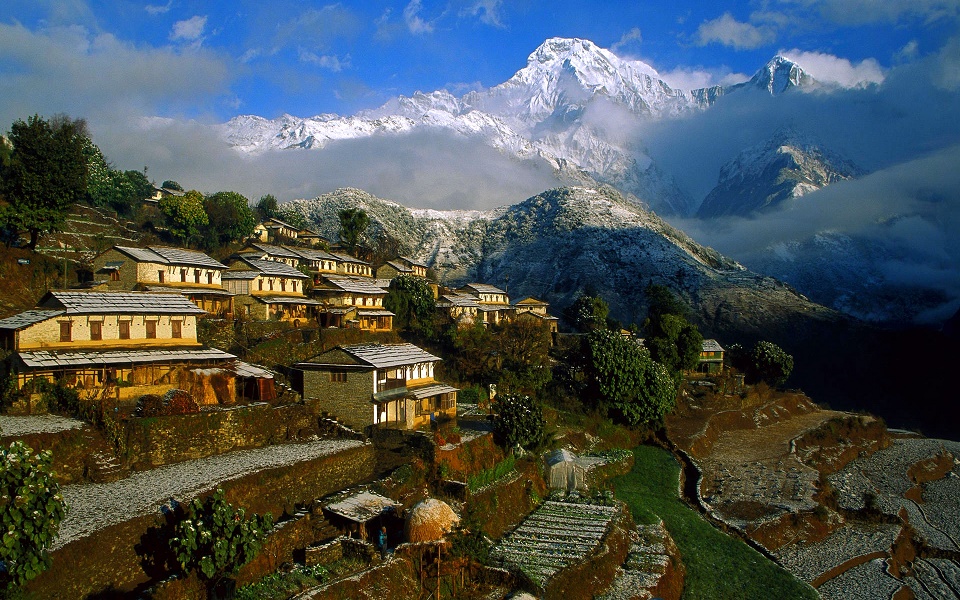

- [Mesha - Aja]
- [Vrishabha - Urisha]
- [Mithuna-Dvamdva]
- Karkata - Kadaga
- [Simha - Leya]
- [Kanya - Parthya]
- [Tula - Vanika]
- [Vṛścika - Thriketta]
- [Dhanus - Haya]
- [Makara - Draco]
- [Kumbha - Ghata]
- [Meena - Antya]
- [Chandra in Karkata]
-
[Mangala-Karkata] [nīcha]
-
[Guru-Karkata ] [uchcha]

AUM som somaya namah
AUM hreem shreem chandraya namah
OM hrinayagrabhaye avyaktya rupine namah
OM Radha-Krishnaya Namah
General Social-Material
effects of the
major periods
as measured from
radical Karkata indriya-lagna
see also the psycho-emotional effects of Vimshottari Dasha periods
as measured from radical Chandra in Karkata

Ketu Mahadasha * The specific social-material effects of the Ketu mahadasha depend explicitly upon Ketu's bhava, ruler, and incoming drishti. Nevertheless, the Vimshottari periods of chidra-karaka Ketu may exhibit some common features. Dispersion of material focus and a tolerance for ambiguity, as well as general apathy toward structure, form, and reality are widely experienced.
Each bhukti of the Ketu mahadasha is definitively commanded by its own bhukti-pati, providing nine alternating contexts for overall Ketu-characterized disintegration of forms and formalities. Nine disconnections, naine dissolutions, and nine surrenders can be expected.
Before Ketu matures at age 48, bhukti of wandering Ketu can produce a significant social-identity disorientation due to Ketu's disregard for social caste or demographic distinctions.
Yet, after 48, the beneficial states of philosophical neutrality toward supposedly permanent social-material laws and structures may begin to predominate in the consciousness, and the result can be blessedly liberating.
Shukra Mahadasha * ruler of 4-11 matures age 25. Before the age of 25, shukra bhukti are focused mainly upon the parents (mūlatrikoṇa-4) and the elder siblings (11).
After age 25, the adult relationship patterns are generally anchored through parenting and community networking. Shukra Mahadasha tends to produce 20 years of stable and economically gainful experience for the Karkata native, albeit there may be some tension between parenting duties and earning duties.
Surya Mahadasha * asset-collector dhanesha-treasurer Surya matures age 22. Before maturity, surya bhukti may focus almost entirely upon the family lineage, its language and historical values; and the acquisition of knowledge. Father-figures and male authorities play a central role, and even a young person may display a regal self-entitlement. Games maybe the preferred family entertainments.
After 22 Professor Surya produces banking, hoarding, and accumulating tendencies which usually result in making of collections, databases, libraries, warehousing, animal herds, and other varieties of cooperage and keep. The individual intelligence is highlighted, expressing uniqueness and non-conformity in behavior. Masculine, creative energy shines brightly for six years, supporting careers in drama, celebrity, politics, fashion, gambling, games, gambits, and artistic performance. It is easier for men than for women to handle Surya's relentlessly bright dry heat, but a feminine actress or politician may be much applauded.
Chandra Mahadasha * lagnesha Chandra matures at age 24. Before 24, chandra's personality vitalizing occurs mainly via physical activity such as sport. A young person is usually concerned with their own appearance, and the emotional stimulus-response pattern that develops first in the bosom of the family and next within the sibling-like cohorts of the teenage friends. When Chandra mahadasha occurs before age 24, one may be characterized as over-sensitive and nurturing, surprising the elders with ability to accept parenting and sheltering roles.
After age 24, the 10-year mahadasha of Chandra suggests a sustained period of self-development and attention to the fleshbody appearance and the social-attribute package that defines personality. Karkata natives tend to be either gardeners of the earth and educators (Punarvasu) or agents of lawful governance (Pushya) or commercial businesspersons, writers and reporters (Aśleṣa). Whichever variety is the native, the behavior is distinctively localized, patriotic, defensive, and protective. Farming and fishing, home and hearth, local defenses, and schoolteaching are primary, security-focused concerns.
Mangala Mahadasha * yogakaraka Kuja activates 5-10. Before age 28, mangala expresses exuberantly in theatre arts, gaming, and dominant roles suited to younger persons such as military and athletic championship.
Once Kuja matures age 28, and depending upon Mangala's placements, Kuja periods are distinctively sexualized and may produce remarkable fortunes in both politics-drama and in executive-leadership roles. Action becomes direct and forthright, preferring the company of males, and aiming to win contests and competitions.
Rahu Mahadasha * although the specific social-material effects of the Rahu mahadasha depend explicitly upon Rahu's bhava, ruler, and incoming drishti, nevertheless Rahu bhukti have some common features. A sharp rise in personal ambition, adesire to experience increased social mobility, and a thrilling empowerment to take risks are all part of the Rahu experience. One is rarely bored and often able to successfully game the system. Near the end of the era, agrand triumph of social ascendance sustained during most of the 18-year Rahu mahadasha may dramatically collapse.
Before Pretentious Professor Rahu matures at age 48, periods of Rahu tend to produce extremes of passion and ambition with limited understanding of the effect that one's actions may have upon others. Before age 48, rahu periods long or short are associated with barrier-bending, taboo-twisting , mixing and mottling of the social categories, and a quest for social mobility at any cost.
After age 48, periods of Rahu tend to produce more tame and manageable results, due to the wisdom of age and the adult understanding that one's actions indeed do affect others. Sudden eruptions of desire for privilege may erupt. Rahu's typical methods of imposture, insinuation, oily-smoky illusions, short-cuts, and appropriation of the work of others may occur in the life pattern, but the urgency to capture the opportunity for glamorous privilege is less intense and risk-taking is more measured.
Guru Mahadasha * Guru activates 6-9, producing very mixed results for Karkata nativities. Until Brihaspati matures age 16, one maybe under sway of the father (9) and the father's profession (6).
After age 16, mahadushtamsha-pati Brihaspati tends to give primarily the results of His mulatrikona Dhanus. The effects of the adversarial satkona may dominate the outcomes. The draining of equity and dissatisfaction typical of Bhava-6 may predominate, particularly when graha occupy 6. Effects of the ideological, doctrinal and philosophical bhava-9 are not forgotten, but theory has less impact than the presence of enemies, injustices, and accusations. Professor Guru simultaneously expands logical argumentation (6) and widens the scope of philosophical wisdom (9).. However, no matter the crimes perpetrated, the attitude toward criminal acts of others is usually wisely forgiving according to the higher doctrines.
Shani Mahadasha * Until Shani matures age 36, periods of Scarcity-imposing Shanaicarya who resists change will mainly produce a relentless pressure to conform to social norms, to keep promises intact with no breakage, and to deny the secret forces of transformation which guarantee the cycles of death and rebirth.
After age 36, shani bhukti are often characterized by a strict demand for conformity and intolerance for individuality, along with a structured focus on the nature of contract law. As the randhresha, shani may signal sudden life-changes which impose new identiy, such as departure of the spouse or uncomfortable issues with the in-laws.
Budha Mahadasha * Budha activates 12-3. Until Budha matures age 32, the main agents are siblings (3) the father's mother (12) and the private imagination including engagement with Other Worlds (12). As a dushtamsha-pati for a young person seeking social importance, budha can produce frustrations of social invisibility.
After age 32, professor Budha may instruct and explain for 17 years Upon matters of psycho-spiritual reality, and stimulate messaging on a variety of topics including divination and spiritual guidance. Often a period of sustained research study punctuated by frequent publications. Favors long sojourn in distant lands, monastic retreat, and most of all writing due to Kanya-3 mulatrikona for Budha..

Ghandruk Village in Kaski district of Gandaki Zone of Nepal * Anna-purna Hima-laya in the background

[How Readings Work] [Sample Sacred Jewels Ratna Recommendation] [Seva]
 file update =
21-Apr-2024
file update =
21-Apr-2024
[Copyright © 1994-2024 by Barbara Pijan Lama] [Contact] [How to Request a Jyotishavidya Reading]
Barbara Pijan Lama Jyotishavidya Vedic Astrology Surya Sun Chandra Moon Mangala Mars Budha Mercury Guru Jupiter Shukra Venus Shani Saturn Rahu Ketu Graha Planets Dasha Timeline Calendar Nakshatra Navamsha Marriage Children Treasury Career Spiritual Wisdom Cycles of re-Death and re-Birth
The information on barbarapijan.com , including all readings and reports, is provided for educational purposes only. Wishing you every happiness and continuing success in studies!